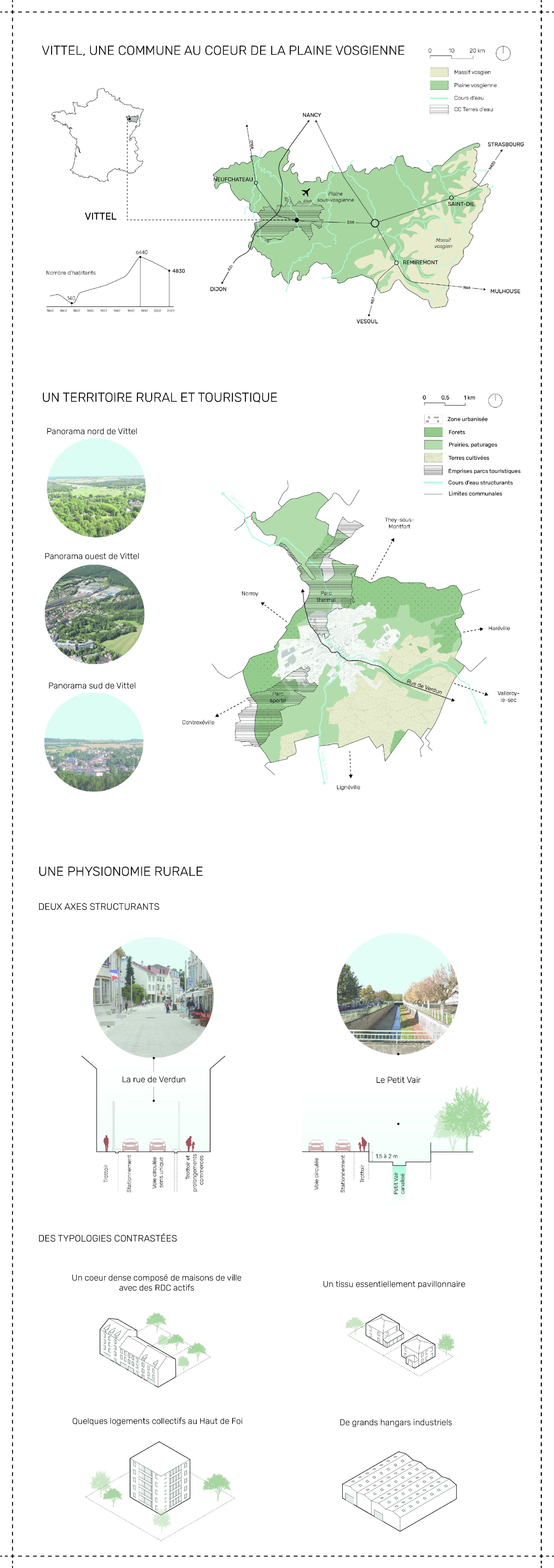Florian LALEVEE
Reconnecter Vittel à son parc thermal
Tout un chacun connait Vittel pour son eau minérale, toutefois il s’agit avant tout d’une petite ville de 4800 habitants perdue au cœur du plateau vosgien.
Vittel est une commune duale, à la fois profondément rurale, mais aussi historiquement touristique. Ces deux facettes s’observent à la fois dans l’organisation et dans le fonctionnement de son territoire. Dans son organisation d’abord, Vittel dispose d’une physionomie rurale. Elle s’organise en effet autour d’un centre-bourg, lui-même ceinturé par un tissu résidentiel essentiellement pavillonnaire, et par un léger mitage industriel qui se projette dans une vaste couronne agricole et forestière. Au-delà de cette essence rurale, Vittel a également été façonnée par le tourisme, et en particulier par un tourisme d’eau dont on retrouve des traces dès l’Antiquité. C’est toutefois durant le XIXème siècle qu’une station thermale pérenne se développa au nord de la ville. On retrouve aujourd’hui de nombreuses traces de cet héritage thermal, tant dans le bourg, avec diverses infrastructures qui ont été réhabilitées à la suite du déclin du thermalisme dans les années 2000, que dans les 650 ha du parc thermal qui accueillent encore aujourd’hui les touristes. Plus récemment, Vittel a également développé un tourisme sportif, profitant de l’installation d’un centre de préparation olympique dans les années 1970 pour aménager un parc omnisport de 650 ha lui aussi, au sud de son territoire.
Forte de cette double attractivité touristique, Vittel est une commune très bien équipée. Toutefois, ses équipements sont concentrés et essentiellement mono-orientés, pour les touristes ou pour les habitants. Vittel apparait dès lors polarisée entre ses deux parcs touristiques, thermal et sportif, et son centre-bourg. Malgré cette polarisation, la ville a pendant longtemps fonctionné selon un certain équilibre. De multiples interactions existaient en effet entre les polarités, et celles-ci en profitaient pleinement, notamment le centre-bourg pour s’équiper et attirer de nouveaux habitants. Aujourd’hui, les polarités touristiques fonctionnent de manière extrêmement introvertie, et la ville doit consentir à d’importants investissements afin de les moderniser et de les redynamiser. Ces investissements s’effectuent néanmoins au détriment du bourg et de ses habitants, qui ne peuvent par ailleurs plus espérer profiter du rayonnement des parcs thermal et sportif qui se referment toujours plus sur eux-mêmes. Entre un centre-bourg vieillissant, des équipements de moins en moins adaptés et une population en forte baisse, les conséquences de cette polarisation sont de plus en plus visibles et inquiétantes.
Plus ou moins consciente de cette réalité, la municipalité mène aujourd’hui différents projets de front, qui permettront à terme de reconnecter à la fois les deux polarités touristiques entre elles, ainsi que le parc sportif au centre-bourg. Dans ce puzzle qui commence à s’assembler, une pièce fondamentale demeure toutefois manquante, à savoir la réarticulation du parc thermal avec le centre-bourg. A partir d’une réflexion sur les moyens de tisser du lien dans une ville polarisée afin de retrouver un certain équilibre, je propose dès lors dans le cadre de ce PFE de répondre à la question suivante : Comment reconnecter Vittel à son parc thermal ?
Afin de reconnecter le bourg et le parc thermal, je propose de suivre une stratégie triface imaginée pour répondre aux trois principaux enjeux que j’ai pu identifier. D’abord, il s’agit de gommer les différentes frontières qui se sont progressivement installées entre ces deux morceaux de ville. Celles-ci relevant essentiellement des mobilités (talus ferroviaire, parking, omniprésence de la voiture, etc.), il s’agit donc de les repenser à partir d’une réflexion à l’échelle urbaine.
Après avoir levé ces multiples verrous urbains, l’enjeu suivant est de tisser du lien entre le parc thermal et le centre-bourg. Il s’agit en effet de donner la possibilité aux touristes de sortir du parc pour rejoindre et redynamiser le bourg, et à l’inverse de permettre aux habitants de s’approprier ce parc alors qu’ils ont peu l’habitude de le côtoyer. Toujours à une échelle urbaine, je propose cette fois de développer une approche par le paysage et les espaces publics. Celle-ci s’appuiera sur la renaturation et le séquençage d’un cours d’eau, le Petit Vair, qui traverse Vittel de nord en sud et qui a été busé et canalisé au début du siècle dernier. Interface naturelle entre les deux polarités, il agit aujourd’hui comme une frontière supplémentaire entre celles-ci. En le transformant en parc linéaire, l’idée est de sortir de cette logique de négation de l’eau, extrêmement paradoxale dans un territoire thermal, et de mettre en réseau une trame verte et des espaces publics épars à travers un nouveau maillage doux et paysager.
A une échelle architecturale cette fois, le dernier enjeu consiste à régénérer des interactions entre les deux polarités. Il s’agit de les faire fonctionner de concert au-delà de simplement les relier, et en particulier d’intégrer le bourg dans le fonctionnement du parc afin de soustraire ce dernier à son introversion. Je propose ainsi d’investir trois sites, trois opportunités le long du Petit Vair, afin d’y injecter une programmation capable d’attirer les touristes dans le bourg, et de répondre aux besoins des habitants d’une commune rurale comme Vittel. Ces interventions, une halle multi-usage, un centre culturel, et des logements de petites typologies couplés à une auberge de jeunesse, établiront différents rapports au Petit Vair, le but étant de l’animer et de le séquencer, tout en adoptant une approche résiliente face aux risques de crues.


















